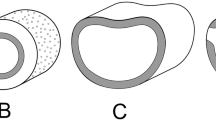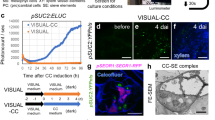Abstract
Prior to long-distance assimilate transport in the blades of Laminariales, photoassimilate from the meristoderm (source tissue) must first be transferred across the cortex before it can be loaded into the sieve elements. This radial assimilate transfer seems to be a symplastic parenchyma transport. The wings of Alaria tenuifolia Setchell are only a few cell layers thick and reveal a continuous cell system interconnecting the meristoderm with the sieve elements. This cell system probably provides an uninterrupted route for the symplastic transverse assimilate transfer and loading. The tissue topography of the wings, the anatomy of the composing cell types, and the micromorphology of the cellular network channelling assimilate to the sieve element system are described. The anatomical results are discussed with regard to the transport physiology of Laminariales in general and the possible mode of sieve element loading.
Similar content being viewed by others
Literature cited
Bisalputra, T.: Electron microscopic study of the protoplasmic continuity in certain brown algae. Can. J. Bot.44, 89–93 (1966)
Buggeln, R. G.: The rate of translocation in Alaria esculenta (Laminariales, Phaeophyceae). J. Phycol. 12, 439–442 (1976)
Buggeln, R. G.: Physiological investigations on Alaria esculenta (Laminariales, Phaeophyceae). II. Role of translocation in blade growth. J. Phycol. 13, 212–218 (1977)
Buggeln, R. G.: Physiological investigations on Alaria esculenta (Laminariales, Phaeophyceae). III. Exudation by the blade. J. Phycol. 14, 54–56 (1978)
Buggeln, R. G.: Source-sink relationships in the blade of Alaria esculenta (Laminariales, Phaeophyceae). J. Phycol. 17, 102–104 (1981)
Buggeln, R. G. and S. Lucken: Kinetic characteristics of photoassimilate translocation in Alaria esculenta (Laminariales, Phaeophyceae). Planta 147, 241–245 (1979)
Giaquinta, R. T.: Phloem loading of sucrose. Ann. Rev. Plant Physiol. 34, 347–387 (1983)
Hellebust, J. A. and A. Haug: Photosynthesis, translocation and alginic acid synthesis in Laminaria digitata and Laminaria hyperborea. Can. J. Bot. 50, 169–176 (1972)
Kibbe, A. L.: Some points in the structure of Alaria fistulosa. Puget Sound mar. Stn. Publ. 1, 43–57 (1915)
Kremer, B. P.: Transversal profiles of carbon assimilation in the fronds of three Laminaria species. Mar. Biol. 59, 95–103 (1980)
Nicholson, N. L.: Anatomy of the medulla of Nereocystis. Bot. Mar. 19, 23–31 (1976)
Oliver, F. W.: On the obliteration of the sieve-tubes in Laminarieae. Ann. Bot. 1, 95–117 (1887)
Parker, B. C.: Translocation in Macrocystis. III. Composition of sieve tube exudate and identification of the major C14-labeled products. J. Phycol. 2, 38–41 (1966)
Parker, B. C. and J. Huber: Translocation in Macrocystis. II. Fine structure of sieve tubes. J. Phycol. 1, 172–179 (1965)
Schmitz, K.: Translocation. In: The biology of seaweeds, pp 534–558. Ed. by C. S. Lobban and M. J. Wynne. Oxford: Blackwell Scientific Publications 1981
Schmitz, K. and R. Kühn: Fine structure, distribution and frequency of plasmodesmata and pits in the cortex of Laminaria hyperborea and L. saccharina. Planta 154, 385–392 (1982)
Schmitz, K., K. Lüning und J. Willenbrink: CO2-Fixierung und Stofftransport in benthischen marinen Algen. II. Zum Ferntransport 14C-markierter Assimilate bei Laminaria hyperborea und Laminaria saccharina. Z. Pflanzenphys. 67, 418–429 (1972)
Schmitz, K. and L. M. Srivastava: Fine structure and development of sieve tubes in Laminaria groenlandica Rosenv. Cytobiol. 10, 66–87 (1974)
Schmitz, K. and L. M. Srivastava: On the fine structure of sieve tubes and the physiology of assimilate transport in Alaria marginata. Can. J. Bot. 53, 861–876 (1975)
Schmitz, K. and L. M. Srivastava: Long distance transport in Macrocystis integrifolia. I. Translocation of 14C-labeled assimilates. Plant Physiol. 63, 995–1002 (1979)
Smith, A. J.: The comparative histology of some of the Laminariales. Am. J. Bot. 26, 571–585 (1939)
Steinbiß, H. H. und K. Schmitz: CO2-Fixierung und Stofftransport in benthischen marinen Algen. V. Zur autoradiographischen Lokalisation der Assimilattransportbahnen im Thallus von Laminaria hyperborea. Planta 112, 253–263 (1973)
Sykes, M. G.: Anatomy and histology of Macrocystis pyrifera and Laminaria saccharina. Ann. Bot. 22, 291–325 (1908)
Wille, N.: Beiträge zur physiologischen Anatomie der Laminariaceen, 70 pp. Christiania: Norske Fredericks Universitet 1897
Author information
Authors and Affiliations
Additional information
Communicated by O. Kinne, Hamburg
Rights and permissions
About this article
Cite this article
Schmitz, K. A cell system for symplastic transport of photoassimilate between meristoderm and sieve elements in Alaria teniufolia . Mar. Biol. 78, 209–214 (1984). https://doi.org/10.1007/BF00394703
Accepted:
Issue Date:
DOI: https://doi.org/10.1007/BF00394703




